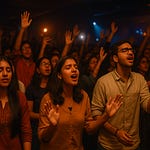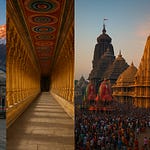In the spiritual heart of Maharashtra lies one of India's most powerful and ancient temples — the Shri Mahalaxmi Temple in Kolhapur, also lovingly known as Ambabai Temple. This sacred shrine is more than just a religious destination. It is an embodiment of centuries-old devotion, mysticism, and cultural heritage. One of the most celebrated events here is the Ambabai Palkhi Sohala, a grand and vibrant procession that draws thousands of devotees from across the country, symbolizing the living presence of the goddess among her people.
🕉️ Origin & Mythological Roots
The origin of the Shri Mahalaxmi Temple is deeply rooted in Hindu mythology. It is believed that after the self-immolation of Sati, parts of her body fell on the earth, creating 51 Shakti Peethas. Kolhapur is said to be the place where her eyes fell, making it a sacred site of immense spiritual energy. This temple, thus, holds the status of a Maha Shakti Peeth.
There is also a unique mythological story that Goddess Mahalaxmi and Lord Vishnu had a disagreement, after which she chose to reside in Kolhapur, while Lord Vishnu stayed in Tirupati. Once a year, the goddess is believed to visit her consort, symbolically uniting the two holy shrines. This annual celestial union is spiritually significant and strengthens the bond between devotees of both deities.
🏛️ Temple Architecture and Timeline
The temple was built in the 7th century by the Chalukya dynasty. Over the centuries, it has seen several expansions and renovations under different rulers including the Yadavas, Shilaharas, and later the Marathas. The temple stands as a classic example of Hemadpanti architecture, carved entirely out of black basalt stone. Its sanctum sanctorum (garbhagriha) houses the idol of Goddess Mahalaxmi, which is about three feet tall, made of black stone, adorned with a crown and heavy jewelry.
A unique feature is the Makara Torana, an intricately carved arch over the idol, and the Deepmal (lamp tower) at the entrance which is over 60 feet tall. Surrounding the main shrine are smaller temples dedicated to deities such as Ganesha, Dattatreya, Vithoba, and the Navagrahas, making it a spiritually rich complex.
🙏 Religious Essence and Significance
Goddess Mahalaxmi or Ambabai is worshipped as the goddess of prosperity, strength, and compassion. She is considered the family deity (Kuldevi) of countless Maharashtrian and Konkani families. Unlike many temples where the goddess is seen as an aspect of another male deity, here she is worshipped as an independent and supreme force.
Devotees believe that the goddess is always awake, alert, and watching over her people, which is symbolized by her idol having open, wide eyes — a rarity in Hindu temple idols. The temple is filled with the divine feminine energy of Shakti and offers a powerful space for prayer, meditation, and spiritual healing.
📿 Daily Puja and Rituals
Each day at the Shri Mahalaxmi Temple begins with a ceremonial Mangal Snan, where the goddess is bathed and dressed. Following this, she is adorned in ornaments during the Alankar Puja. Devotees offer prayers and Naivedya (food offerings). One of the most significant rituals is the Abhishek, where the idol is bathed with milk, honey, and sacred water.
Several aartis are performed throughout the day, starting with Kakad Aarti in the early morning, followed by Shringar Aarti, Maha Aarti around noon, Dhoop Aarti in the evening, and the Shej Aarti at night before the temple closes.
🔮 The Power of the Shlok
A powerful mantra often chanted at the temple is:
"ॐ श्रीं ह्रीं क्लीं महालक्ष्म्यै नमः"
Om Shreem Hreem Kleem Mahalakshmyai Namah
This mantra invokes the goddess’s divine energy of wealth, protection, and spiritual awakening.
🚩 Ambabai Palkhi Sohala – The Sacred Procession
The Ambabai Palkhi Sohala is one of the most iconic and emotionally powerful events at the temple. Held on auspicious days like Ashwin Shuddha Ashtami during Navratri, the Magha Navami, and other special festivals, the palkhi (palanquin) carrying the representation of the goddess is taken out through the streets of Kolhapur.
The procession is marked by devotees dressed in traditional attire, beating dhols and tashas, dancing in unison, singing bhajans, and loudly chanting praises of Ambabai. The palkhi stops at various historical and religious points along the way, where special prayers and aartis are conducted. The belief is that the goddess herself steps out of her sanctum to bless her people during this sacred event.
🔍 Mystical and Unique Aspects
One of the most mystical aspects of this temple is the belief that the idol of the goddess is self-manifested (Swayambhu) — it wasn’t sculpted but appeared on its own. Another mystical connection is the spiritual bond with Tirupati Balaji, which devotees see as a reminder that the divine masculine and feminine energies are always connected, even when distant.
Also, during certain times of the year, the rays of the sun fall directly on the idol's face — an astronomical alignment considered divinely significant and a marvel of ancient temple architecture.
🧳 How to Reach Kolhapur
Kolhapur is well-connected by all modes of transport:
By Train: Kolhapur Railway Station (CPR) is connected to major cities like Pune, Mumbai, Bangalore, and Goa. The temple is just a 10-minute ride by auto from the station.
By Air: Kolhapur has a small domestic airport with flights from Mumbai. Alternatively, you can fly to Pune or Belgaum and drive 3–4 hours to reach Kolhapur.
By Road: The city is connected via highways and is accessible by buses or private cars from major cities across Maharashtra and Karnataka.
🏨 Accommodation and Food
Kolhapur offers a wide range of accommodation options — from budget lodges and dharamshalas for pilgrims to luxury hotels for families and tourists. The city is also known for its spicy and flavorful cuisine. Don’t miss out on Kolhapuri Misal, Tambda Rassa, and Pandhra Rassa — all served with a traditional flair.
🗓️ Best Time to Visit
The best time to visit the Shri Mahalaxmi Temple is between October and March, especially during Navratri and Diwali when the temple is decorated with lights and flowers and special ceremonies take place. February and March are also ideal months due to the celebration of Rathotsav, the grand chariot festival. Monsoon (June to August) offers a scenic experience with cooler temperatures, but one must be prepared for rainfall.
Avoid the peak summer months of April and May due to high temperatures.
🛍️ Other Attractions in Kolhapur
Apart from the temple, Kolhapur offers other spiritual and tourist destinations such as the Jyotiba Temple, Rankala Lake, Panhala Fort, and the New Palace Museum. The city is also famous for its handcrafted Kolhapuri chappals, traditional jewelry, and jaggery (gud).
🧘 Spiritual Experience Beyond Worship
A visit to Shri Mahalaxmi Temple is not just a ritual — it is a spiritual experience. The sound of temple bells, the fragrance of incense, the visual grandeur of the idol, and the collective energy of thousands of devotees combine to create a moment of transcendence. Many visitors speak of a strange calm, inner clarity, and emotional release after their visit — a sign of true spiritual connection.
The Shri Mahalaxmi Temple of Kolhapur is a sacred powerhouse of divine feminine energy, architectural brilliance, and unwavering devotion. Whether you're attending the mesmerizing Ambabai Palkhi Sohala, seeking blessings for wealth and prosperity, or simply looking for a soulful experience, this temple has something deeply transformational to offer.










